Insufficient Cold Resistance as a Possible Reason for the Absence of Darkling Beetles (Coleoptera, Tenebrionidae) in Pleistocene Sediments of Siberia
Abstract
Simple Summary
Abstract
1. Introduction
- Measurement of the cold-resistance parameters of several species of darkling beetles from the arid highlands of Altai (Chuya Depression), a region known for its cold winters.
- Based on the literature, assessment of the climatic (air and soil temperatures, snowdepth) conditions in the modern range of the darkling beetles studied.
- Estimation of specific temperature conditions in the soils of the darkling beetle habitat using data loggers.
- Correlation of the cold resistance of darkling beetles with temperature conditions in the modern range of the studied species in the South-Eastern Altai and Central Asia, and comparison to the reconstructed conditions of the tundra-steppe territories of Western Siberia and the Northeast Asia in the late Pleistocene.
2. Materials and Methods
2.1. Region and Location of Work
- It should be an arid region with extremely low temperatures in winter.
- The entomofauna of the region should be close to the Pleistocene fauna of the West Siberian Plain.
- The region should be located near an operating weather station in order to be tied to a long-term climate base.
2.2. Selection of Darkling Beetle Species
- They should be abundant, with autumn activity.
- Species known from Pleistocene deposits are desirable.
- If possible, species should belong to different taxonomic groups to reveal patterns across different phyletic lineages of the family.
2.3. Distribution and Ecology of Species
2.4. Studying the Resistance of Darkling Beetles to Negative Temperatures
2.4.1. Insect Acclimation
2.4.2. Determination of the Supercooling Point (SCP)
2.4.3. Determination of Low Lethal Temperature (LLT)
2.5. Study of Overwintering Conditions
2.5.1. Winter Temperatures in the Range of the Studied Species
2.5.2. Overwintering Conditions for Darkling Beetles in Natural Habitats
3. Results
3.1. Cold Resistance of Darkling Beetles
3.1.1. Supercooling Point
3.1.2. Low Lethal Temperature
3.2. Climatic Conditions in the Modern Range of Darkling Beetles
3.3. Overwintering Conditions for Darkling Beetles in Natural Habitats
3.3.1. Temperatures in the Overwintering Microhabitat
3.3.2. Temperature Conditions in the Chuya Depression during the Last 90 Years
3.3.3. Early Spring Observation of the Overwintering Microhabitats of Darkling Beetles
4. Discussion
4.1. Cold-Resistance Parameters of Darkling Beetles
4.1.1. Supercooling Point
4.1.2. Comparison of SCP and LLT
4.2. Climate in the Region
4.2.1. Bottom of the Chuya Depression
4.2.2. Mountain Habitat around the Chuya Depression
4.3. Cold Resistance of Darkling Beetles and Overwintering Temperatures
4.3.1. Contradiction between the Cold Resistance of Darkling Beetles and Regional Conditions
4.3.2. Heterogeneity of the Topography and Vegetation within the Territory
4.3.3. Overwintering Depth
4.3.4. Recovery of Darkling Beetle Populations after Extremely Cold Winters
4.4. Climatic Conditions of the Late Pleistocene of Siberia and the Darkling Beetle
4.4.1. South of the West Siberian Plain
4.4.2. Northeast Siberia
5. Conclusions
Author Contributions
Funding
Data Availability Statement
Acknowledgments
Conflicts of Interest
References
- Elias, S.A. Quaternary Insects and Their Environments; Smithsonian Institution Press: Washington, DC, USA; London, UK, 1994; pp. 1–284. [Google Scholar]
- Coope, G.R. Coleoptera analysis. In Handbook of Holocene Palaeoecology and Palaeohydrology; Berglund, B.E., Ed.; Wiley: New York, NY, USA, 1986; pp. 703–713. [Google Scholar]
- Coope, G.R. The response of Late Quaternary insect communities to sudden climatic changes. In Organization of Communities, Past and Present; Gee, J.H.R., Giller, P.S., Eds.; Blackwell Scientific Publications: Oxford, UK, 1987; pp. 421–438. [Google Scholar]
- Kiselev, S.V. Pozdnekainozoiskie Zhestkokrylye Severo-Vostoka Sibiri [Late Cenozoic Coleoptera of Northeastern Siberia]; Nauka: Moscow, Russia, 1981; pp. 1–116. [Google Scholar]
- Kuzmina, S.A. Macroentomology analysis: Methods, opportunities, and examples of reconstructions of paleoclimatic and paleoenvironmental conditions in the Quaternary of the northeastern Siberia. Contemp. Probl. Ecol. 2017, 10, 336–349. [Google Scholar] [CrossRef]
- Berman, D.I.; Alfimov, A.V.; Mazhitova, G.G.; Grishkan, I.B.; Yurtsev, B.A. Cold Steppe in North-Eastern Asia; Dalnauka: Vladivostok, Russia, 2001; pp. 1–185. [Google Scholar]
- Gurina, A.A. Pozdnechetvertichnye Zhestkokrylye Yugo-Vostoka Zapadno-Sibirskoi Ravniny [Late Quaternary Coleoptera of the Southeast West Siberian Plain]. Ph.D. Thesis, Institute of Systematics and Ecology of Animals, SB RAS, Novosibirsk, Russia, 2019. [Google Scholar]
- Gurina, A.A.; Dudko, R.Y.; Prosvirov, A.S.; Tshernyshev, S.E.; Legalov, A.A.; Zinovyev, E.V. Coleoptera assemblages from the Quaternary deposits of Kizikha river, the southernmost late Pleistocene insects of the West Siberian Plain. Invertebr. Zool. 2019, 16, 165–182. [Google Scholar] [CrossRef]
- Dudko, R.Y.; Danukalova, G.A.; Gurina, A.A.; Ivanov, A.V.; Mikhailov, Y.E.; Osipova, E.M.; Prosvirov, A.S.; Solodovnikov, A.Y.; Legalov, A.A.; Zinovyev, E.V. Insects and molluscs of the Late Pleistocene at the Gornovo site (Southern Ural foreland, Russia): New data on palaeoenvironment reconstructions. Quat. Int. 2022, 632, 154–177. [Google Scholar] [CrossRef]
- Abdurakhmanov, G.M.; Nabozhenko, M.V. Keys and Catalogue to Darkling Beetles (Coleoptera: Tenebrionidae s. str.) of the Caucasus and South of European Part of Russia; KMK Scientific Press: Moscow, Russia, 2011; pp. 1–361. [Google Scholar]
- Sagdy, C.T. Ecological complexes of tenebrionids (Coleoptera, Tenebrionidae) in the Ubsunur Hollow (Tuva). Entomol. Obozr. 1995, 74, 568–581. [Google Scholar]
- Mordkovich, V.G.; Dudko, R.J.; Khudyaev, S.A.; Lyubechanskii, I.I. Changes in the Ground Beetle and Darkling Beetle Communities (Coleoptera: Carabidae, Tenebrionidae) in the Mountain Hollows of the Tuva and Altai Republics over 60 Years: A Trend or a Fluctuation? Contemp. Probl. Ecol. 2022, 15, 579–596. [Google Scholar] [CrossRef]
- Hou, F.; Ma, J.; Liu, X.; Wang, Y.; Liu, X.N.; Zhang, F.C. Seasonal changes in antifreeze protein gene transcription and water content of beetle Microdera punctipennis (Coleoptera: Tenebrionidae) from Gurbantonggut desert in Central Asia. Cryoletters 2010, 31, 359–370. [Google Scholar] [PubMed]
- Sinclair, B.J.; Chown, S.L. Rapid cold-hardening in a Karoo beetle, Afrinus sp. Physiol. Entomol. 2006, 31, 98–101. [Google Scholar] [CrossRef]
- Miller, L.K. Production of threitol and sorbitol by an adult insect: Association with freezing tolerance. Nature 1975, 258, 519–520. [Google Scholar] [CrossRef]
- Li, N.G. Ice-nucleating activity of hemolymph of Upis ceremboides beetle inhabiting in central Yakutia. Probl. Cryobiol. Cryomed 2011, 21, 34–45. [Google Scholar]
- Pilnikova, Z.N. (Ed.) Nauchno-Prikladnoi Spravochnik Po Klimatu SSSR [Scientific and Applied Reference Book on the Climate of the USSR]; Issue 20, Gidrometeoizdat: Saint-Petersburg, Russia, 1993; pp. 1–719. [Google Scholar]
- Weather and Climate. Available online: http://www.pogodaiklimat.ru/climate.php (accessed on 15 October 2023).
- Ogloblin, D.A.; Kolobova, A.N. Zhuki Chernotelki (Tenebrionidae) i ih Lichinki, Vredyashchie Polevodstvu. Trudy Poltavskoi s.kh. Opytnoi Stantsii. Entomologicheskii Otdel [Darkling Beetles (Tenebrionidae) and Their Larvae that Damage Crop Production. Proceedings of Poltava Agricultural Experimental Station. Entomological Department]; No. 61; Poltava-Poligraf: Poltava, Russia, 1927; pp. 1–60. [Google Scholar]
- Medvedev, G.S. Keys to the darkling beetles of Mongolia. In Proceedings of the Zoological Institute; Kirejtshuk, A.G., Ed.; Zoologicheskii Institut, Akademii Nauk SSSR: Leningrad, Russia, 1999; Volume 220, pp. 1–253. [Google Scholar]
- Nabozhenko, M.; Chigray, I. Tribe Blaptini. In Catalogue of Palaearctic Coleoptera; Iwan, D., Löbl, I., Eds.; Brill: Leiden, The Netherlands; Boston, MA, USA, 2020; Volume 5, pp. 268–296. [Google Scholar]
- Maadyrool, U.A.; Sagdy, C.T. Trophoecological groups of darkling beetles (Coleoptera, Tenebriondae) of Tuva. Bull. Krasn. State Ped. Univ. 2011, 1, 220–225. [Google Scholar]
- Knor, I.B. Ecological and faunal review of darkling beetles (Coleoptera, Tenebrionidae) of steppe and forest-steppe landscapes of Western Siberia. In Fauna Sibiri; Yudin, B.S., Ed.; Nauka: Novosibirsk, Russia, 1973; pp. 93–106. [Google Scholar]
- Knor, I.B. Darkling Beetle (Coleoptera, Tenebrionidae) of the steppe mountain depressions of Tuva. In Chlenistonogie Sibiri. Fauna Sibiri; Zolotarenko, G.S., Ed.; Nauka: Novosibirsk, Russia, 1978; pp. 74–92. [Google Scholar]
- Egorov, L.V. Tenebrionid beetles of the tribe Platyscelidini (Coleoptera, Tenebrionidae) of the fauna of Kirghizia. Entomol. Obozr. 1999, 78, 122–131. [Google Scholar]
- Sinclair, B.J.; Alvarado, L.E.C.; Ferguson, L.V. An invitation to measure insect cold tolerance: Methods, approaches, and workflow. J. Therm. Biol. 2015, 53, 80–197. [Google Scholar] [CrossRef]
- Berman, D.I.; Meshcheryakova, E.N.; Alfimov, A.V.; Leirikh, A.N. The distribution of the earthworm Dendrobaena octaedra (Lumbricidae: Oligochaeta) in the north of the Holarctic is limited by insufficient frost resistance. Zool. Zh. 2002, 81, 1210–1221. [Google Scholar]
- Shulgin, A.M. Klimat Pochv i Ego Regulirovanie [Soil Climate and Its Regulation]; Gidrometeoizdat: Leningrad, Russia, 1972; pp. 1–340. [Google Scholar]
- All-Russia Research Institute of Hydrometeorological Information, World Data Centre. Available online: https://www.meteo.ru.climate.sp_clim.php (accessed on 15 February 2023).
- Spravochnik Po Klimatu SSSR [USSR Climate Guide], Issue 20, Part 2; Gidrometeoizdat: Leningrad, Russia, 1965; pp. 1–396.
- Spravochnik Po Klimatu SSSR [USSR Climate Guide], Issue 20, Part 4; Gidrometeoizdat: Leningrad, Russia, 1969; pp. 1–331.
- Spravochnik Po Klimatu SSSR [USSR Climate Guide], Issue 23, Part 2; Gidrometeoizdat: Leningrad, Russia, 1966; pp. 1–319.
- Spravochnik Po Klimatu SSSR [USSR Climate Guide], Issue 23, Part 4; Gidrometeoizdat: Leningrad, Russia, 1968; pp. 1–328.
- Lebedev, A.N.; Kodrau, O.D. (Eds.) Klimaticheskii Spravochnik Zarubezhnoi Azii. Chapter 1 [Climate Reference Book of Foreign Asia. Part 1]; Gidrometeoizdat: Leningrad, Russia, 1974; pp. 1–540. [Google Scholar]
- Dorjgotov, D. (Ed.) National Atlas of Mongolia; Institute of Geography, The Academy Science of Mongolia: Ulaanbaatar, Mongolia, 2009; pp. 1–248. [Google Scholar]
- National Centers for Environmental Information. Available online: https://www.ncei.noaa.gov/ (accessed on 15 February 2023).
- RP5.ru. Weather for 240 Countries of the World. Available online: https://rp5.ru/Weather_in_the_world (accessed on 15 March 2023).
- Gehrken, U.; Strømme, A.; Lundheim, R.; Zachariassen, K.E. Inoculative freezing in overwintering tenebrionid beetle, Bolitophagus reticulatus Panz. J. Insect Physiol. 1991, 37, 683–687. [Google Scholar] [CrossRef]
- Danks, H.V. Modes of seasonal adaptation in the insects. Can. Entomol. 1978, 110, 1167–1205. [Google Scholar] [CrossRef]
- Olsen, T.M.; Sass, S.J.; Li, N.; Duman, J.G. Factors contributing to seasonal increases in inoculative freezing resistance in overwintering fire-colored beetle larvae Dendroides canadensis (Pyrochroidae). J. Exp. Biol. 1998, 201, 1585–1594. [Google Scholar] [CrossRef]
- Denlinger, D.L.; Lee, R.E., Jr. Low Temperature Biology of Insects; Cambridge University Press: Cambridge, UK, 2010; pp. 1–389. [Google Scholar]
- Berman, D.I.; Leirikh, A.N. Overwintering and Cold Hardiness of the Invertebrates in the Northeast Asia; KMK Scientific Press Ltd.: Moscow, Russia, 2019; pp. 1–314. [Google Scholar]
- Salin, C.; Vernon, P.; Vannier, G. Cold resistance in the lesser mealworm Alphitobius diaperinus (Panzer) (Coleoptera: Tenebrionidae). CryoLetters 2003, 24, 111–118. [Google Scholar] [PubMed]
- Duman, J.G. The role of macromolecular antifreeze in the darkling beetle Meracantha contracta. J. Comp. Physiol. 1977, 115, 279–286. [Google Scholar] [CrossRef]
- Tusong, K.; Guo, X.; Meng, S.; Liu, X.; Ma, J. Comparative analysis of the transcriptome of the overwintering desert beetle Microdera punctipennis. Cryobiology 2017, 78, 1210–1221. [Google Scholar] [CrossRef]
- Block, W. Insects and freezing. Sci. Prog. 1995, 78, 349–372. [Google Scholar]
- Alfimov, A.V.; Berman, D.I. Two poles of cold under the Eurasian snow cover. Priroda 2006, 6, 27–33. [Google Scholar]
- Dostovalova, M.S. Regime forming factors of cryogenic-pressure flooding of the territory of Kosh-Agach village. Prir. Resur. Gorn. Altaya 2006, 1, 85–90. [Google Scholar]
- Agatova, A.; Nepop, R.; Nazarov, A.; Ovchinnikiv, I.; Moska, P. Climatically Driven Holocene Glacier Advances in the Russian Altai Based on Radiocarbon and OSL Dating and Tree Ring Analysis. Climate 2021, 9, 162. [Google Scholar] [CrossRef]
- Berman, D.I.; Bulakhova, N.A.; Alfimov, A.V.; Meshcheryakova, E.N. How the most northern lizard, Zootoca vivipara, overwinters in Siberia. Polar. Biol. 2016, 39, 2411–2425. [Google Scholar] [CrossRef]
- Sevastyanov, V.V. Climate of High-Mountainous Areas of Altai and Sayan; Publishing House Tomsk State University: Tomsk, Russia, 1998; pp. 1–201. [Google Scholar]
- Pilnikova, Z.N. (Ed.) Nauchno-Prikladnoi Spravochnik po klimatu SSSR [Scientific and Applied Reference Book on the Climate of the USSR]; Issue 13, Gidrometeoizdat: Leningrad, Russia, 1990; pp. 1–725. [Google Scholar]
- Bakhmetiev, P.I. Theoretical and practical results from my studies of animal anabiosis. Priroda 1912, 12, 1427–1442. [Google Scholar]
- Salt, R.W. Studies on the Freezing Process in Insects; University of Minnesota Agricultural Experiment Station: St. Paul, MN, USA, 1936; pp. 1–41. [Google Scholar]
- Berman, D.I.; Alfimov, A.V.; Zhigulskaya, Z.A.; Leirikh, A.N. Overwintering and Cold-Hardiness of Ants in the Northeast of Asia; Pensoft Publishers: Moscow, Russia; Sofia, Bulgaria, 2010; pp. 1–294. [Google Scholar]
- Nekrasov, I.A. Taliki Rechnykh Dolin i Zakonomernosti ikh Rasprostraneniya [Taliks of River Valleys and Patterns of Their Distribution]; Nauka: Moscow, Russia, 1967; pp. 1–140. [Google Scholar]
- Kuular, K.B. Land surface temperature in the Tyva Republic in the winters of 2014–2017 by Landsat-8. Sovrem. Probl. Dist. Zondirovan. Zemli Kosmosa 2018, 15, 67–77. [Google Scholar] [CrossRef]
- Zinovyev, E. Sub-fossil beetle assemblages associated with the “mammoth fauna” in the Late Pleistocene localities of the Ural Mountains and West Siberia. ZooKeys 2011, 100, 149–169. [Google Scholar] [CrossRef] [PubMed]
- Velichko, A.A. (Ed.) Paleoclimates and Paleoenvironmens of Extra-Tropical Regions of the Northern Hemisphere. Late Pleistocene—Holocene. Atlas-Monograph; GEOS: Moscow, Russia, 2009; pp. 1–120+24 maps. [Google Scholar]
- Novenko, E.Y. Rastitelnost i Klimat Tsentralnoi i Vostochnoi Evropy v Pozdnem Pleistotsene i Golotsene [Vegetation and Climate of Central and Eastern Europe in the Late Pleistocene and Holocene]. Ph.D. Thesis, MSU, Moscow, Russia, 2016. [Google Scholar]
- Alfimov, A.V.; Berman, D.I. Possible errors of the mutual climatic range (MCR) method in reconstructing the Pleistocene climate of Beringia. Entomol. Rev. 2009, 89, 487–499. [Google Scholar] [CrossRef]
- Fletcher, T.L.; Csank, A.Z.; Ballantyne, A.P. Identifying bias in cold season temperature reconstructions by beetle mutual climatic range methods in the Pliocene Canadian High Arctic. Palaeogeogr. Palaeoclimatol. Palaeoecol. 2019, 514, 672–676. [Google Scholar] [CrossRef]
- Zykin, V.S.; Zykina, V.S.; Orlova, L.A. Reconstruction of changes in the natural environment and climate of the Late Pleistocene based on sediments of Lake Aksor. Archaeol. Ethnol. Anthropol. Eurasia 2003, 16, 2–16. [Google Scholar]
- Zykina, V.S.; Zykin, V.S. Loess-Soil Sequence and Environment and Climate Evolution of West Siberia in Pleistocene; Academic Publishing House “GEO”: Novosibirsk, Russia, 2012; pp. 1–477. [Google Scholar]
- Zinovyev, E.V. Insect Fauna of the Ural and West Siberian Plain in the Quaternary Period. Ph.D. Thesis, Institute of Plant and Animal Ecology, UB RAS, Ekaterinburg, Russia, 2020. [Google Scholar]
- Gurina, A.A.; Dudko, R.Y.; Ivanov, A.V.; Kotov, A.A.; Mikhailov, Y.E.; Prokin, A.A.; Prosvirov, A.S.; Solodovnikov, A.Y.; Zinovyev, E.V.; Legalov, A.A. New Data on the Distribution of Southern Forests for the West Siberian Plain during the Late Pleistocene: A Paleoentomological Approach. Diversity 2023, 15, 56. [Google Scholar] [CrossRef]
- Chytrý, M.; Horsák, M.; Danihelka, J.; Ermakov, N.; German, D.A.; Hájek, M.; Hájková, P.; Kočí, M.; Kubešová, S.; Lustyk, P.; et al. A modern analogue of the Pleistocene steppe-tundra ecosystem in southern Siberia. Boreas 2019, 48, 36–56. [Google Scholar] [CrossRef]
- Vasil’chuk, Y.K. Izotopno-Kislorodnyi Sostav Podzemnykh L’dov [Oxygen Isotope Composition of Underground Ice]; MSU: Moscow, Russia, 1992; Volume 1, pp. 1–420. [Google Scholar]
- Vasil’chuk, Y.K. Izotopno-Kislorodnyi Sostav Podzemnykh L’dov [Oxygen Isotope Composition of Underground Ice]; MSU: Moscow, Russia, 1992; Volume 2, pp. 1–264. [Google Scholar]
- Vasil’chuk, Y.K.; Kotlyakov, V.M. Principles of Isotope Geocryology and Glaciology; MSU: Moscow, Russia, 2000; pp. 1–614. [Google Scholar]

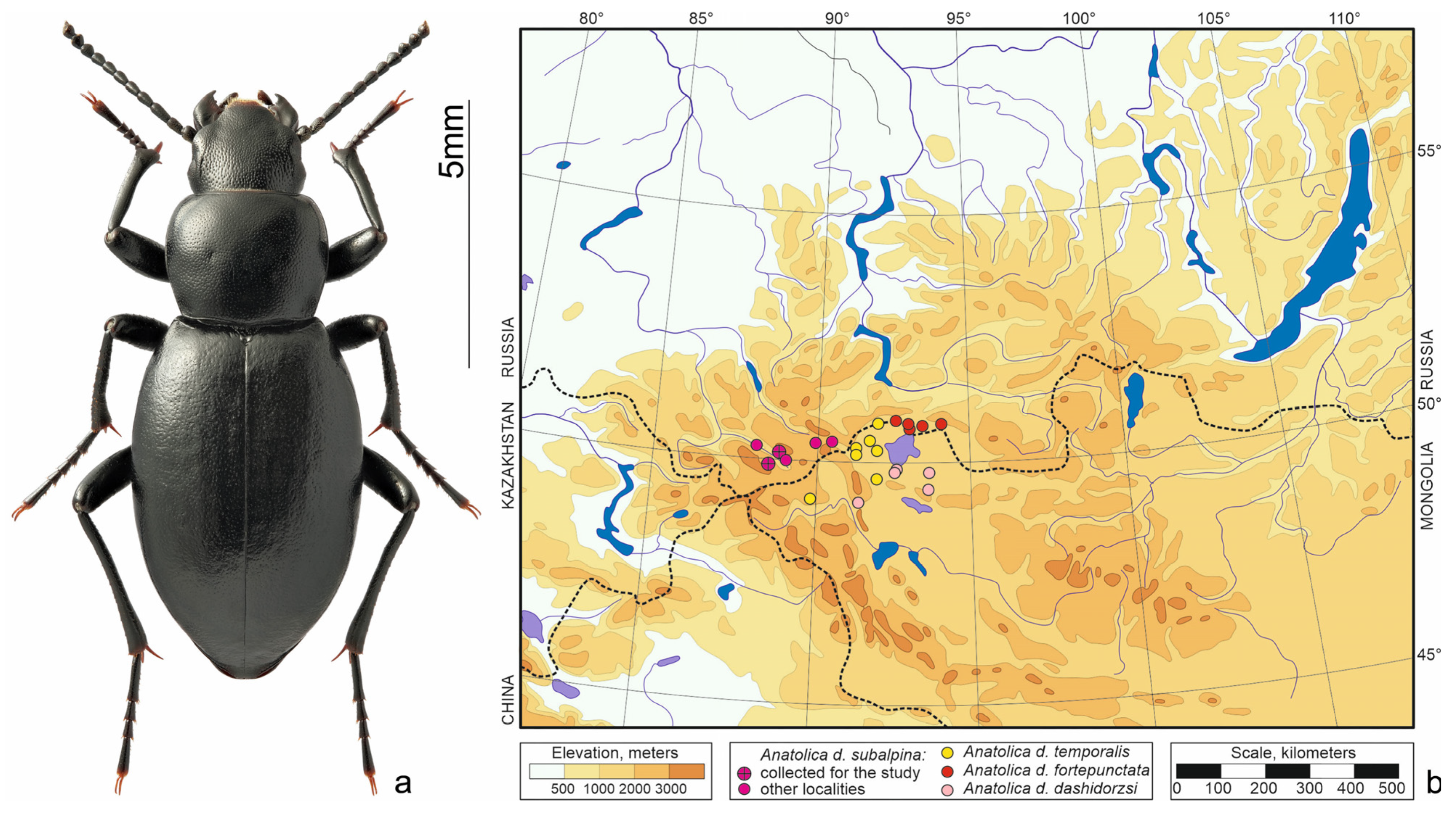
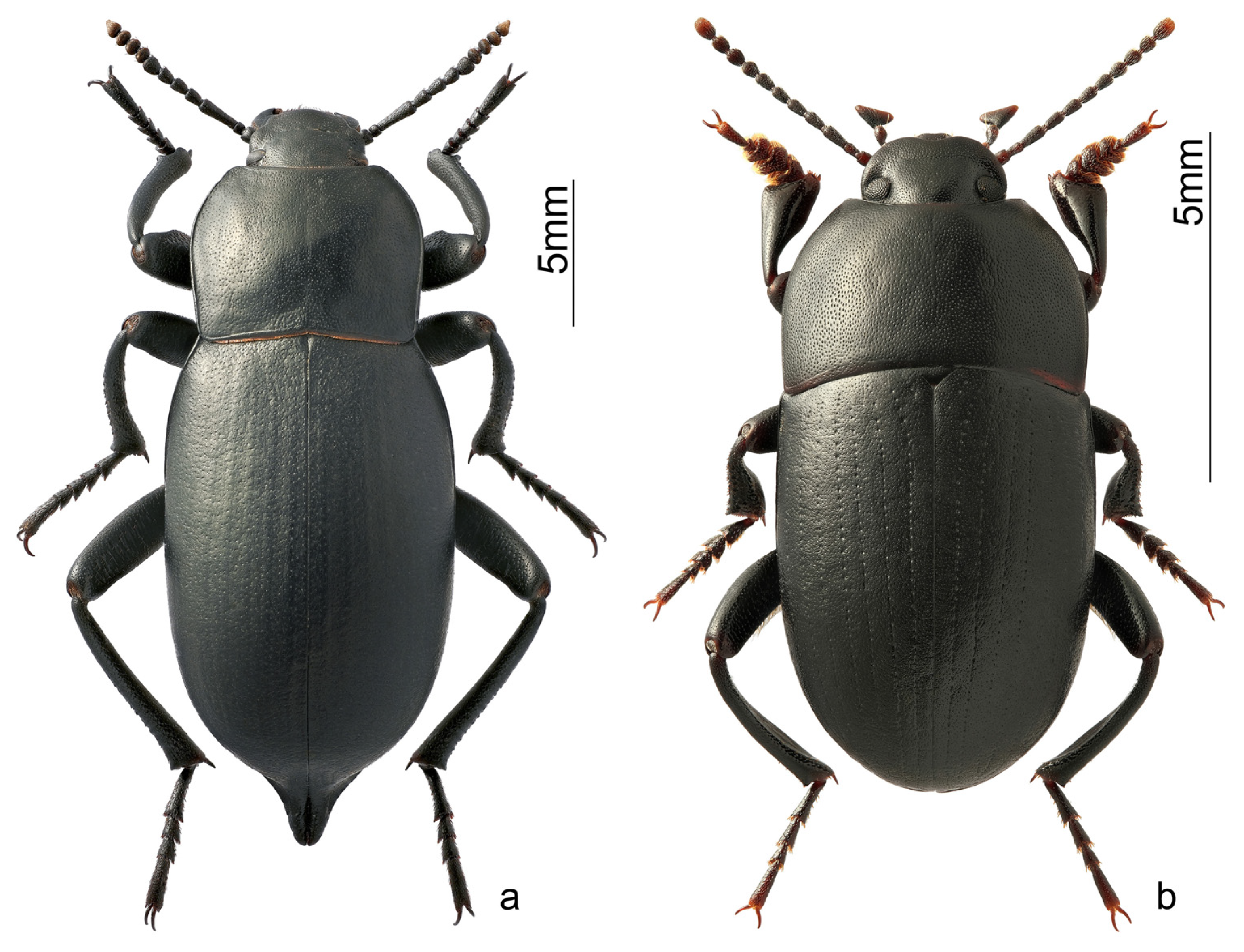
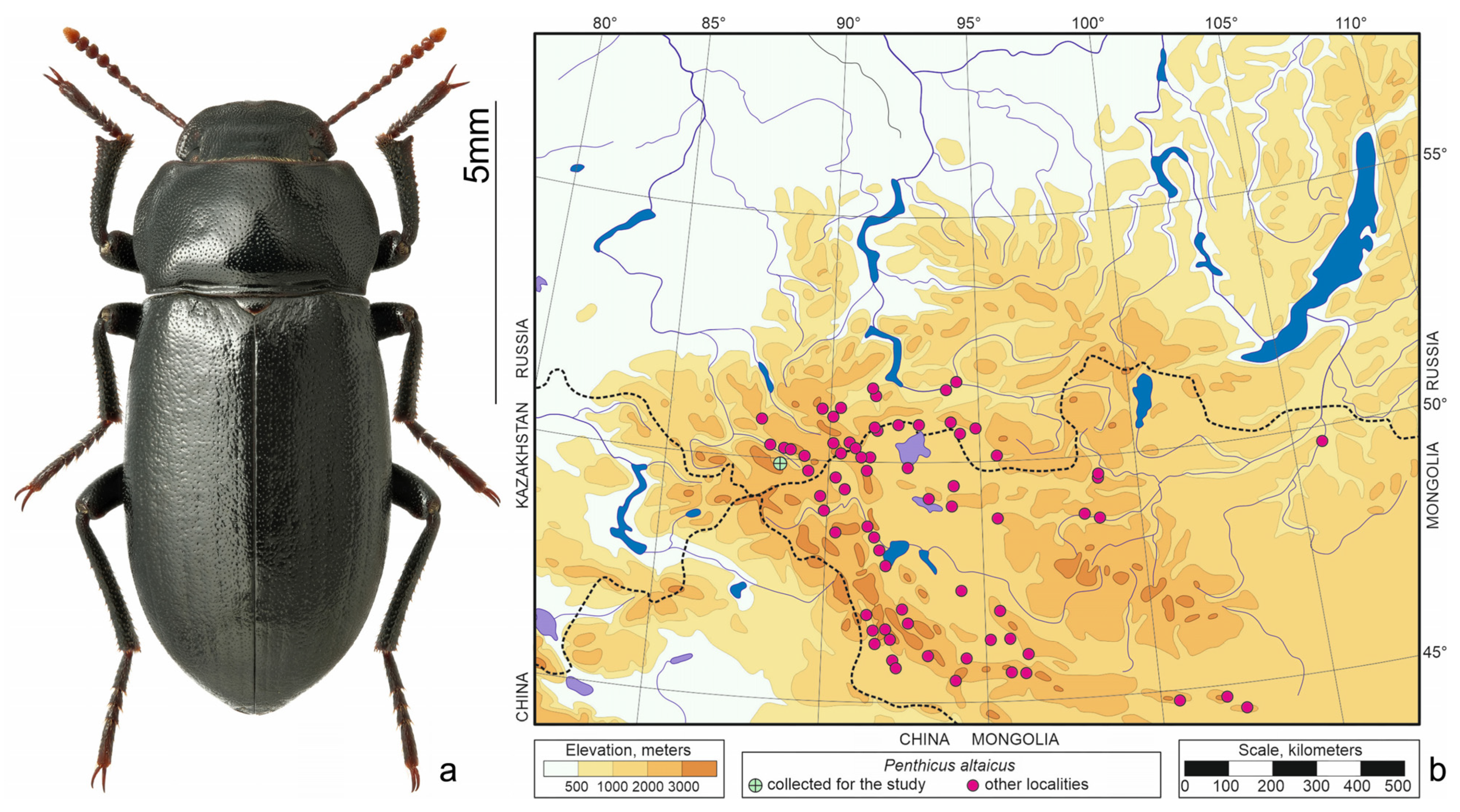

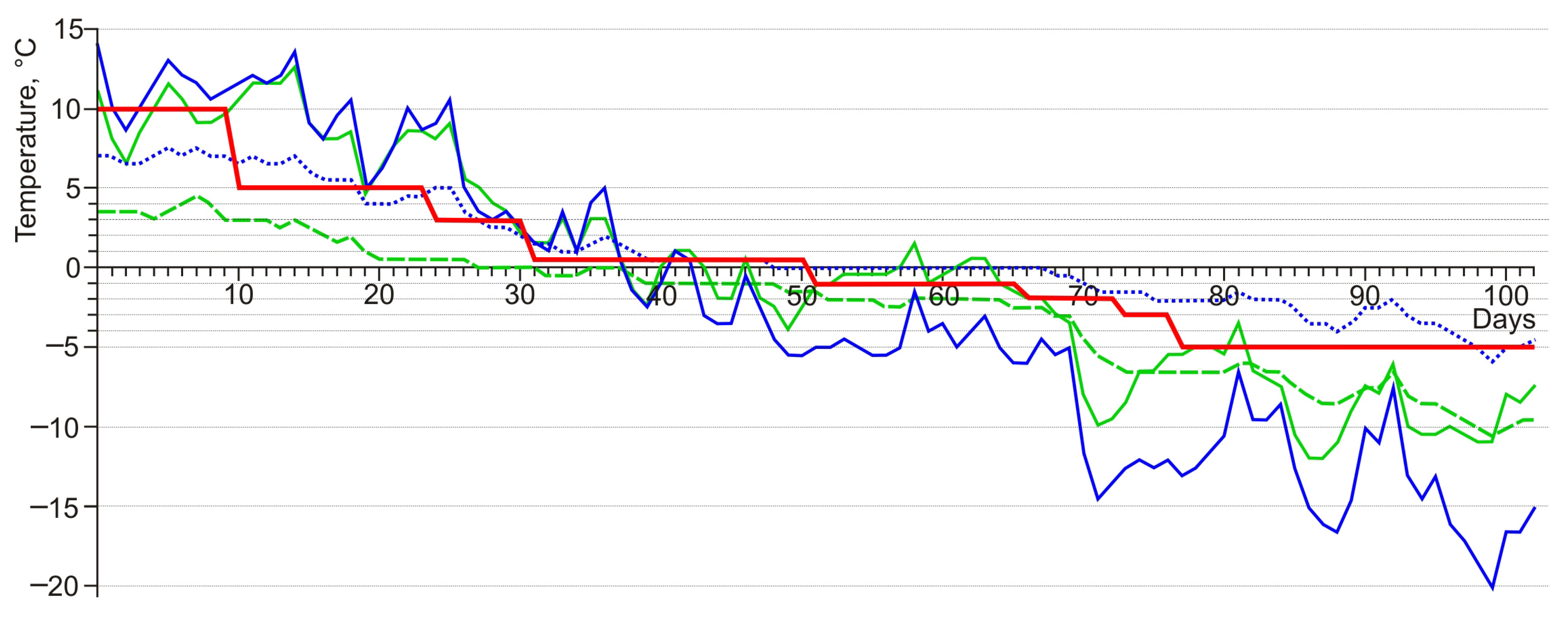
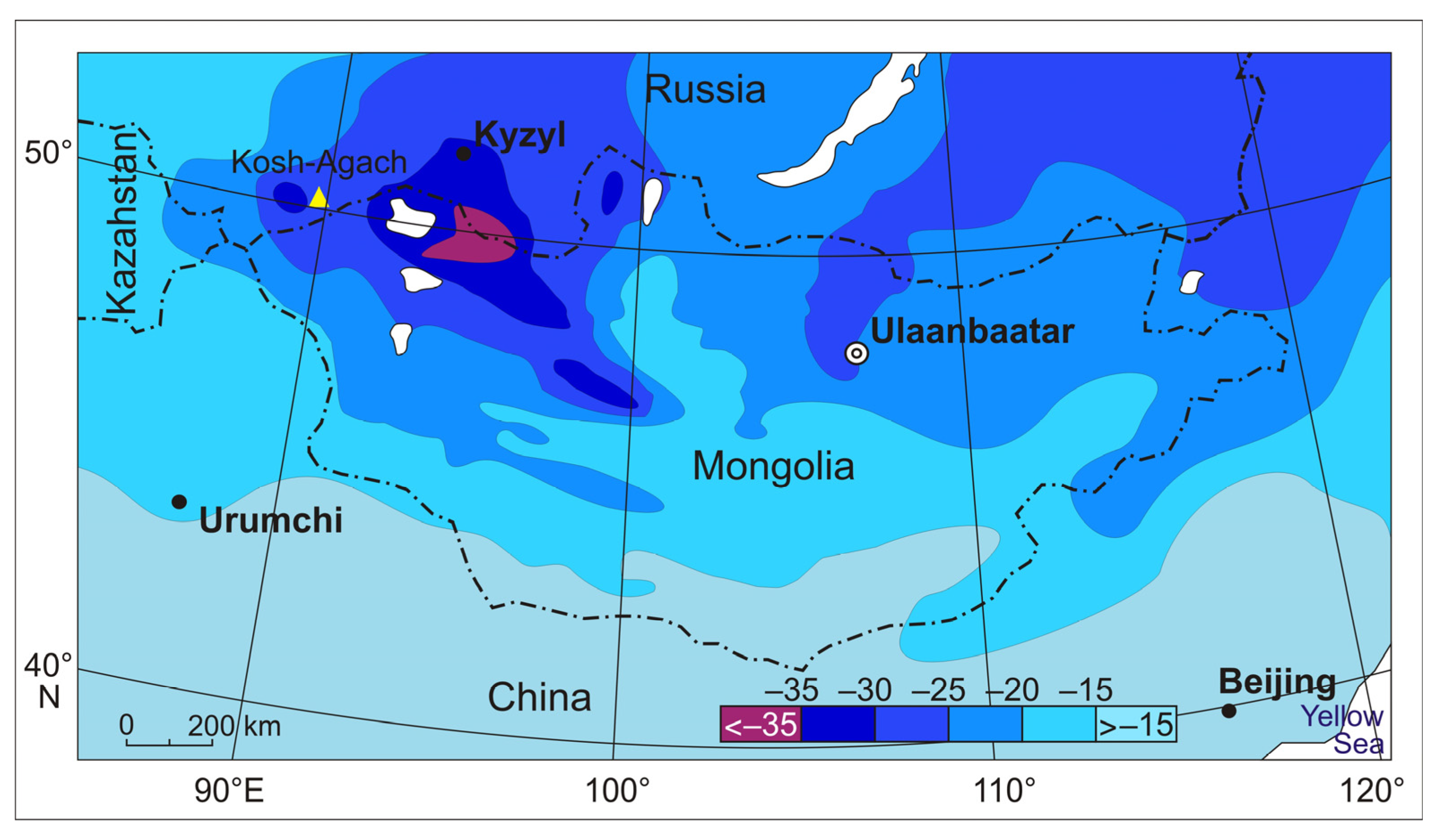
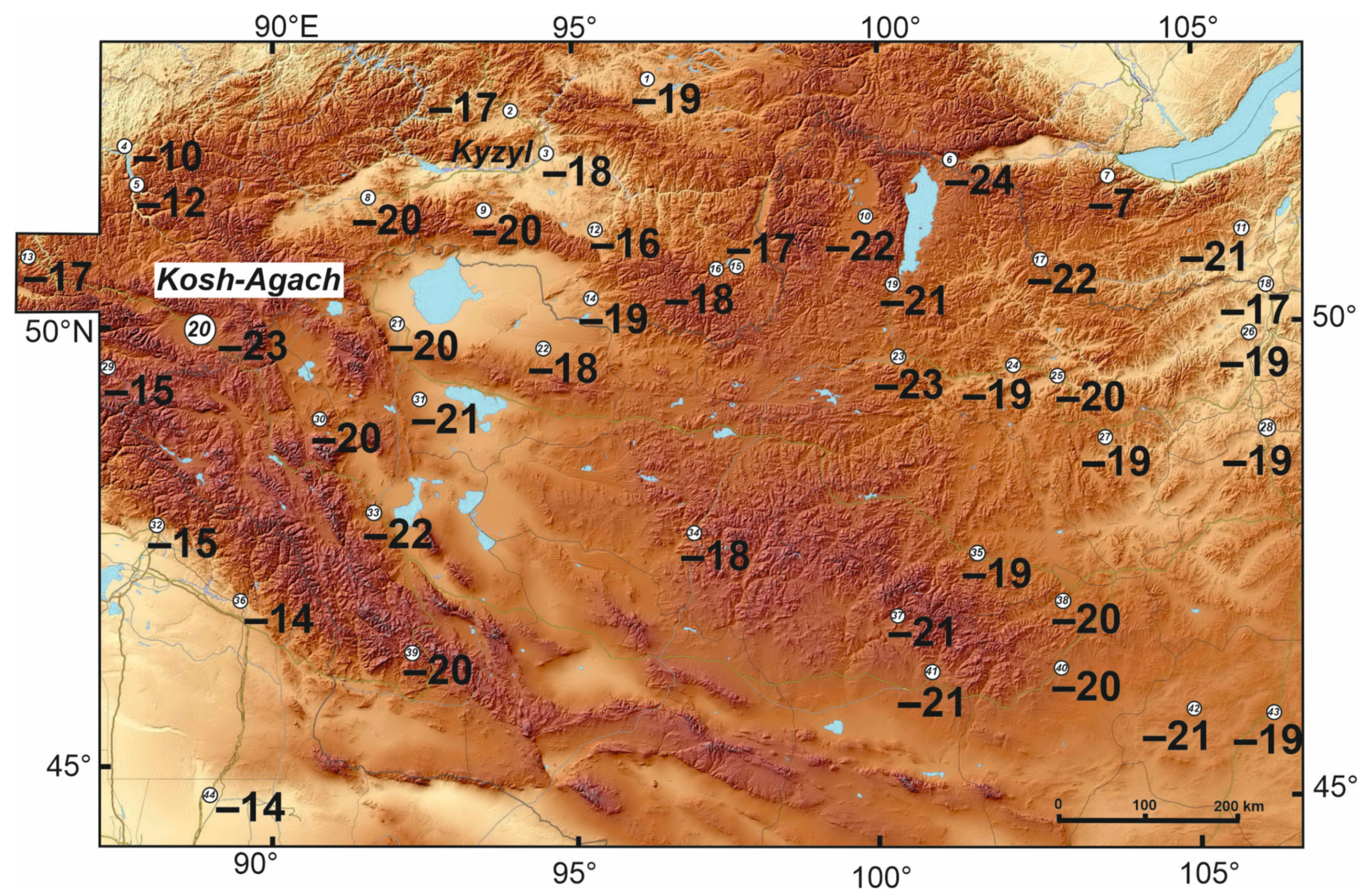
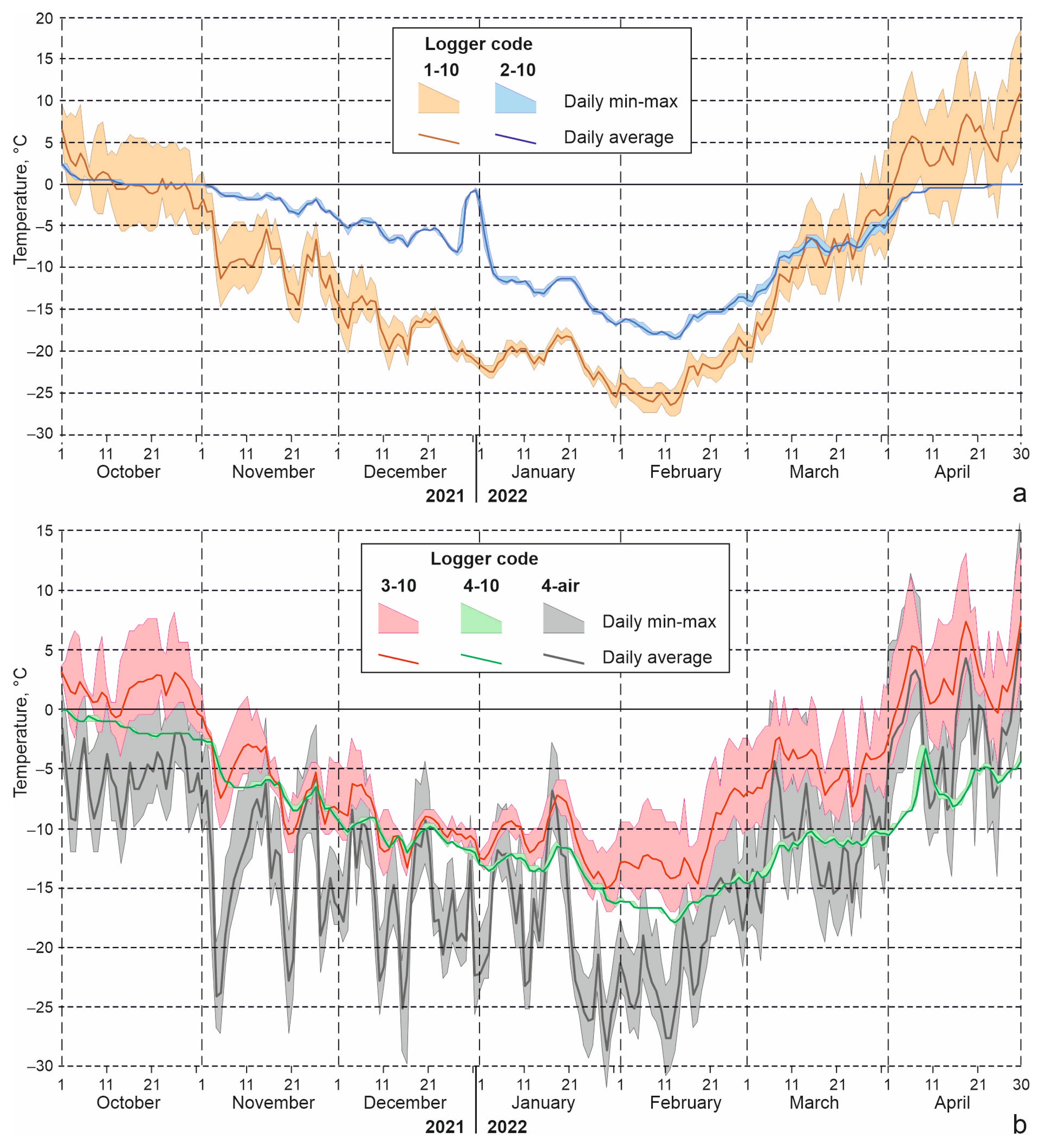

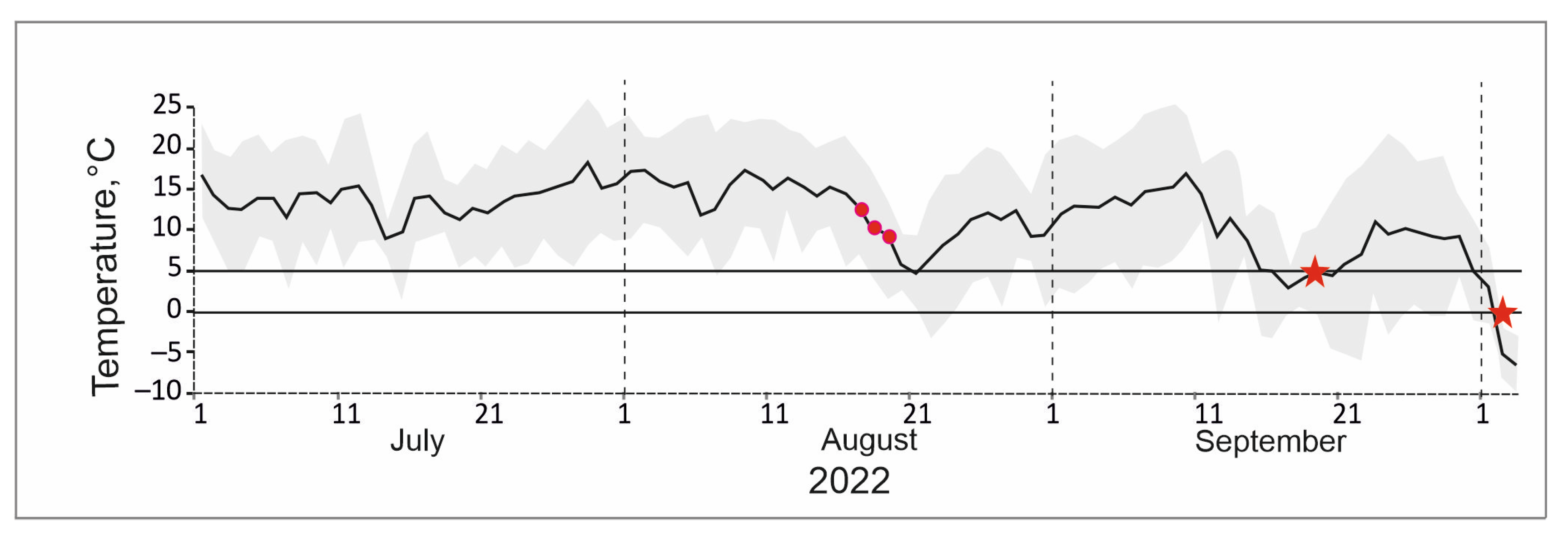
| Species, Stage * | Collection Site | Height A.S.L., m | Number of Specimens |
|---|---|---|---|
| Anatolica dashidorzsi, Im | Beltir Village, 49.931° N, 88.117° E | 1970 | 123 |
| Kosh-Agach Village, 49.941° N, 88.706° E | 1760 | ||
| Blaps lethifera, Im | Ongudai Village, 50.725° N, 86.206° E | 800 | 120 |
| Pedinus femoralis, Im | 31 | ||
| Penthicus altaicus, Im | Beltir Village, 49.931° N, 88.117° E | 1970 | 219 |
| Bioramix picipes, Im | Tabozhok Mt., 50.061° N, 88.807° E | 2250 | 133 |
| Bioramix picipes, L | 7 |
| Species, Stage | SCP * | LLT * |
|---|---|---|
| Anatolica dashidorzsi, Im | + | + |
| Penthicus altaicus, Im | + | + |
| Pedinus femoralis, Im | + | − |
| Blaps lethifera, Im | + | + |
| Bioramix picipes, Im | + | + |
| Bioramix picipes, L | + | − |
| Locality | Logger No. | Depth/Height Above Ground Level, cm | Season | Coordinates | Elevation A.S.L., m | Relief, Soil |
|---|---|---|---|---|---|---|
| Chuya Depression, Kosh-Agach Village | 1-1 | −1 | 2021–2022; 2022–2023 | 49.9422° N, 88.7069° E | 1761 | Positive relief element, xeromorphic |
| 1-10 | −10 | |||||
| 2-air | 150 | 2021–2022 | 49.9474° N, 88.7087° E | 1759 | Floodplain of the Chaganka River, wet | |
| 2-1 | −1 | |||||
| 2-10 | −10 | |||||
| Kuraisky Mt. Range, Tabozhok Mt. | 3-1 | −1 | 2021–2022; 2022–2023 | 50.0615° N, 88.8101° E | 2280 | Slope of southern exposure, xeromorphic |
| 3-10 | −10 | |||||
| 4-air | 150 | 50.0607° N, 88.8100° E | 2270 | Foot of a north-facing slope, mesomorphic | ||
| 4-1 | −1 | 2021–2022 | ||||
| 4-10 | −10 |
| Species, Stage | Season | n | Mean SCP | Min SCP |
|---|---|---|---|---|
| Anatolica dashidorzsi, Im | winter | 35 | −25.7 ± 0.9 | −34.9 |
| Penthicus altaicus, Im | autumn | 18 | −13.1 ± 0.9 | −22.4 |
| winter | 43 | −25.0 ± 0.6 | −31.9 | |
| Bioramix picipes, Im | winter | 23 | −21.7 ± 1.3 | −29.4 |
| Bioramix picipes, L | winter | 7 | −28.7 ± 0.3 | −30.0 |
| Pedinus femoralis, Im | winter | 31 | −19.3 ± 0.7 | −26.1 |
| Blaps lethifera, Im | winter | 20 | −15.1 ± 0.3 | −17.4 |
| Species | Date | T, °C | n | Survivors, % |
|---|---|---|---|---|
| Anatolica dashidorzsi | 16.01 | −5 | 19 | 63 |
| 9.02 | −5 | 14 | 71 | |
| 17.01 | −20 | 22 | 36 | |
| 26.12 | −24 | 33 | 6 | |
| Penthicus altaicus | 16.01 | −5 | 20 | 55 |
| 9.02 | −5 | 26 | 81 | |
| 17.01 | −20 | 26 | 69 | |
| 26.12 | −24 | 41 | 24 | |
| 25.01 | −30 | 45 | 0 | |
| Bioramix picipes, Im | 16.01 | −5 | 18 | 95 |
| 9.02 | −5 | 16 | 100 | |
| 26.12 | −22 | 29 | 55 | |
| 19.01 | −25 | 17 | 18 | |
| 25.01 | −30 | 30 | 0 | |
| Blaps lethifera, Im | 16.01 | −5 | 15 | 63 |
| 9.02 | −5 | 5 | 80 | |
| 17.01 | −10 | 20 | 60 | |
| 9.02 | −13 | 25 | 32 | |
| 29.12 | −15 | 10 | 10 | |
| 1.02 | −17 | 25 | 0 |
| Locality | Elevation, m a.s.l. | Logger No. * | 2021–2022 | 2022–2023 | ||||
|---|---|---|---|---|---|---|---|---|
| 1 cm | 10 cm | Air | 1 cm | 10 cm | Air | |||
| Kosh-Agach | 1761 | 1 | −32.1 (−29.2) | −27.8 (−26.4) | – | −30.6 −26.6) | −26.7 (−24.4) | – |
| 1759 | 2 | −20.6 (−20.1) | −18.6 (−18.4) | −41.2 | – | – | – | |
| Tabozhok | 2280 | 3 | −24.6 (−17.2) | −17.0 (−15.0) | – | −21.1 (−19.0) | −17.5 (−17.0) | – |
| 2270 | 4 | −21.2 (−20.7) | −18.1 (−17.8) | −32.2 | – | – | −35.2 | |
| Long-Term Average Minimum of Soil Temperatures ± SE, °C | Snow Depth in January, cm | ||||
|---|---|---|---|---|---|
| At the Weather Station | Snow Survey | ||||
| 20 cm | 40 cm | 80 cm | Mean | Maximum | |
| −27.0 ± 0.45 | −21.5 ± 0.35 | −13.7 ± 0.33 | 8 | 5.8 | 15.3 |
Disclaimer/Publisher’s Note: The statements, opinions and data contained in all publications are solely those of the individual author(s) and contributor(s) and not of MDPI and/or the editor(s). MDPI and/or the editor(s) disclaim responsibility for any injury to people or property resulting from any ideas, methods, instructions or products referred to in the content. |
© 2024 by the authors. Licensee MDPI, Basel, Switzerland. This article is an open access article distributed under the terms and conditions of the Creative Commons Attribution (CC BY) license (https://creativecommons.org/licenses/by/4.0/).
Share and Cite
Dudko, R.Y.; Alfimov, A.V.; Gurina, A.A.; Meshcheryakova, E.N.; Reshetnikov, S.V.; Legalov, A.A.; Berman, D.I. Insufficient Cold Resistance as a Possible Reason for the Absence of Darkling Beetles (Coleoptera, Tenebrionidae) in Pleistocene Sediments of Siberia. Insects 2024, 15, 64. https://doi.org/10.3390/insects15010064
Dudko RY, Alfimov AV, Gurina AA, Meshcheryakova EN, Reshetnikov SV, Legalov AA, Berman DI. Insufficient Cold Resistance as a Possible Reason for the Absence of Darkling Beetles (Coleoptera, Tenebrionidae) in Pleistocene Sediments of Siberia. Insects. 2024; 15(1):64. https://doi.org/10.3390/insects15010064
Chicago/Turabian StyleDudko, Roman Yu., Arcady V. Alfimov, Anna A. Gurina, Ekaterina N. Meshcheryakova, Sergei V. Reshetnikov, Andrei A. Legalov, and Daniil I. Berman. 2024. "Insufficient Cold Resistance as a Possible Reason for the Absence of Darkling Beetles (Coleoptera, Tenebrionidae) in Pleistocene Sediments of Siberia" Insects 15, no. 1: 64. https://doi.org/10.3390/insects15010064
APA StyleDudko, R. Y., Alfimov, A. V., Gurina, A. A., Meshcheryakova, E. N., Reshetnikov, S. V., Legalov, A. A., & Berman, D. I. (2024). Insufficient Cold Resistance as a Possible Reason for the Absence of Darkling Beetles (Coleoptera, Tenebrionidae) in Pleistocene Sediments of Siberia. Insects, 15(1), 64. https://doi.org/10.3390/insects15010064







